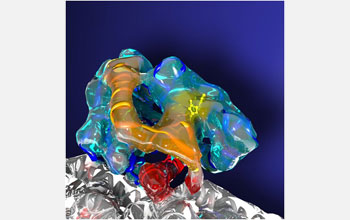Multimedia Gallery
Cell Transportation Network
Like a major city, our cells use a complex transportation network to deliver molecular goods to different destinations. A protein called kinesin (blue) is in charge of moving cargo around inside cells and helping them divide. It's powered by biological fuel called ATP (bright yellow) as it scoots along tube-like cellular tracks called microtubules (gray). Since kinesin's movement helps support cell division, blocking its action could potentially derail cancer.
This picture captures a moment in cellular time, where kinesin is stopped in its tracks. It was derived from images captured through a type of electron microscopy that uses a beam of electrons to produce an intensely magnified, high-resolution snapshot of a sample at extremely low temperatures. (Date of Image: February 2010)
Credit: Charles Sindelar, Brandeis University
Images and other media in the National Science Foundation Multimedia Gallery are available for use in print and electronic material by NSF employees, members of the media, university staff, teachers and the general public. All media in the gallery are intended for personal, educational and nonprofit/non-commercial use only.
Images credited to the National Science Foundation, a federal agency, are in the public domain. The images were created by employees of the United States Government as part of their official duties or prepared by contractors as "works for hire" for NSF. You may freely use NSF-credited images and, at your discretion, credit NSF with a "Courtesy: National Science Foundation" notation.
Additional information about general usage can be found in Conditions.
Also Available:
Download the high-resolution JPG version of the image. (243 KB)
Use your mouse to right-click (Mac users may need to Ctrl-click) the link above and choose the option that will save the file or target to your computer.

